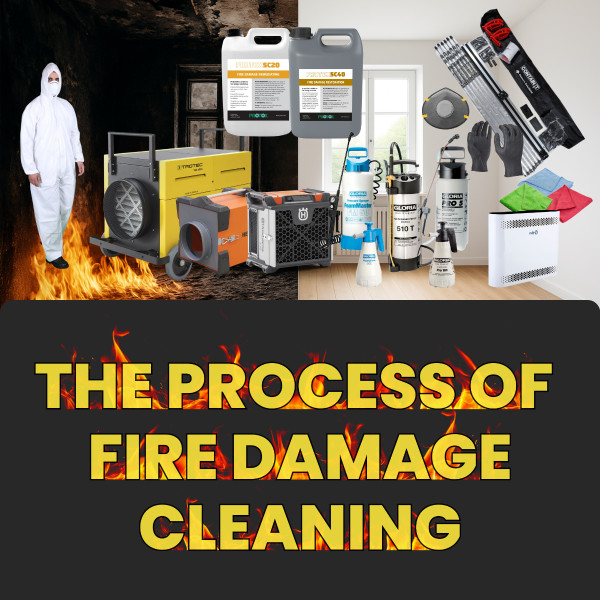The Process of Fire Damage Cleaning
How to Use SC40 & SC20 with the Right Tools and PPE
Fire damage restoration is a tough job. It needs the right chemicals and the right equipment. You also need personal protective gear and good cleaning methods.
At Restore Solutions, we are proud to offer two of the best fire and smoke damage products available: Protox SC40 and Protox SC20. Each product is made to deal with different levels and types of fire-related contamination.
Learn a simple step-by-step restoration process for using these products. Discover the best tools and safety gear. This will help you achieve efficient, thorough, professional, and safe cleaning results.
Step 1: Understand the Type of Fire Damage You're Facing
Which Product Should You Choose? Before selecting a cleaning agent, assess the damages by type and severity:
|
Feature |
SC40 |
SC20 |
|---|---|---|
|
Use Cases |
Severe fire damage, heavy residues |
General fire remediation, soft materials |
|
pH Level |
Higher (stronger) |
Lower (gentler) |
|
Best For |
Oil fires, heavy soot, industrial use |
Paper fires, soft furnishings, delicate items |
|
Foaming Ability |
High – more contact time |
Moderate – better rinsing |
|
Dilution |
5-10% |
20:1 to 100:1 |
Each product is powerful in its own right but requires the right approach to achieve the best results.
Step 2: Set Up Your Workspace for Safety and Containment
Whether you're cleaning a home or industrial site, preparation is key. Set up your space with the following essentials:
- PPE: Nitrile gloves, carbon mask, safety goggles, and disposable coveralls.
- Containment materials: Use containment kits and zippers to isolate the area.
- Air treatment: Position air cleaners (such as our Heylo, Husqvarna, or Trotec models) and hydroxyl generators to control odours and airborne contaminants.
This step ensures a safer environment for you and minimises cross-contamination during cleaning.
Step 3: Cleaning with SC40 – The Heavy-Duty Cleaner for Fire Damage
If you have stubborn, greasy, and oily residues, Protox SC40 is the product for you. Its higher pH level makes it a very strong cleaner. It's capable of breaking down tough soot, grease, and oil-based contaminants that other cleaners struggle with.
What You'll Need:
- Gloria Foamer or Trigger Sprayer – For even, clinging application to walls and ceilings.
- Duop – For agitation and rinsing.
- Microfibre Cloths – For final wipe-down.
- Warm water (above 55°C) – For effective rinsing.
- (Optional) Restore Solutions Wisp – Add a fresh scent to your cleaning solution.
Application Steps:
- Dilute SC40 at 5–10% depending on contamination level.
- Foam the surface using the Gloria Foamer or Trigger Sprayer, ensuring full coverage on walls or hard surfaces.
- Leave the solution sit for 15 minutes for maximum effect.
- Agitate with the Duop scrubbing pad to lift soot and residue.
- Rinse using the clean mop pad or microfibre cloth soaked in warm water.
- Repeat on heavily soiled sections as needed.
- For an added fragrance, add Wisp to your SC40 mix.
⚠️ Note: SC40 has a high pH and should only be used with full PPE:
- Nitrile Gloves
- Eye Protection
- Carbon Mask
- ContainIT Full Body Coveralls
Step 4: Cleaning with SC20 – The Gentle Yet Effective Cleaner for Sensitive Fire Damage
Protox SC20 is great for cleaning delicate materials and general fire damage. SC20 has a lower pH, which means it cleans more safely and carefully. This makes it good for sensitive surfaces like furniture, textiles, carpets, and paper.
What You'll Need:
- Trigger Sprayer or Foamer – For soft application.
- Sponge or Duop – For gentle agitation.
- Microfibre Cloths – For wiping down.
- (Optional) Restore Solutions Wisp – To enhance the scent.
Application Steps:
- Dilute SC20 based on use:
-
- Surface Cleaning: 100:1.
- Degreasing: 50:1.
- Fire Damage Remediation: 20:1 or 10:1.
- Apply with sprayer or foamer, allowing even distribution.
- Allow to sit for 5 minutes.
- Agitate gently with a sponge or Duop.
- Wipe or rinse with clean water and microfibre cloths.
- (Optional) Restore Solutions Wisp – Add a fresh scent to your cleaning solution.
✅ SC20 is safe for more delicate environments, but gloves and masks are still recommended during use.
Step 5: Air and Odour Control for a Complete Finish
Don’t stop at surface cleaning. To restore the entire environment damaged by fire:
- Run air cleaners during and after cleaning to remove particulates.
- Use hydroxyl generators to neutralise lingering odours.
- Keep containment barriers in place until the area is fully cleared.
These steps ensure thorough and professional restoration services that meets industry standards.
Summary: What You'll Need for Each Job
|
Task |
Equipment Product |
|---|---|
|
Surface Application |
|
|
Agitation |
|
|
Rinsing & Wipe Down |
|
|
Fragrance Boost |
|
|
Air Filtration |
Heylo, Trotec or Husqvarna Air Cleaners |
|
Odour Control |
|
|
Containment |
|
|
Personal Protection |
Need the Technical Breakdown?
Curious about the specific differences between SC40 and SC20?
Want to learn more about pH levels, ideal surfaces, and use case comparisons?
Recent Posts
-
Ten Years of Restore Solutions: Innovation for Restorers
In 2015, Restore Solutions entered the market with one clear purpose — to help restoration professio …2nd Dec 2025 -
The Ultimate Battery Operated Power Scrubber for Restoration Professionals
Less Elbow Grease, More Results: Meet the Battery-Powered Scrubber That Does the Hard Work for You S …17th Nov 2025 -
Choosing the Right Cleaning Chemicals in Restoration: Work Smarter, Work Safer
Chemical safety isn’t an optional extra in restoration — it’s the foundation of professional, consis …9th Nov 2025




